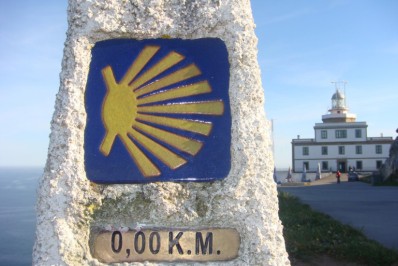Camino a Fisterra y Muxía (The Way to Fisterra and Muxía)
From Santiago de Compostela to Fisterra. 4 sections. 90 kilometres. Alternative Route to Muxía
This route of the Camino de Santiago does not have the Galician capital as its destination, but as its starting point towards Cape Fisterra and the Chapel of the Virxe da Barca in Muxía.
It is a kind of epilogue that leads pilgrims to extend their journey to what was believed to be the westernmost part of Europe, what the ancients considered the End of the World or the Finis Terrae.
The Road to Fisterra and Muxía is a millenary route that dates back to prehistoric civilizations, which continued with the Celts and was assimilated by Christianity. It is born from the tradition of walking towards the west, following the movement of the sun, to discover the limits of the known world. Fisterra is one of those magical spots where the sun is engulfed by the ocean, creating a very magical atmosphere, full of spirituality, that many pilgrims want to experience every year.
The Codex Calixtinus explains how the disciples of the Apostle travelled to Dugium, the current Fisterra, looking for an authorisation from the Romans to bury the Saint in Compostela. Already in the 9th century, when the remains were discovered, many pilgrims continued walking until the Costa da Morte or Death Coast.
Apparition of the Virgin in Muxía
Muxía is the other goal of this Camino that begins in Santiago. The Church of A Virxe da Barca merges with the rocks and the sea. Legend has it that the Virgin Mary arrived there on a stone ship to encourage the Apostle during his mission.
The pilgrim who arrives at the Sanctuary of Muxía will be able to contemplate three stones that, according to tradition, were part of the boat that carried the Virgin there: the hull, the sail and the rudder of the ship.
The helmet is identified with the Pedra de Abalar (abalar stone), to which healing and fertility properties were attributed.The candle is better known as Pedra dos Cadrís (kidney stone). Tradition calls for going under this stone nine times to relieve back pain. Finally, the pilgrim will also find the Pedra do timón (rudder stone).
Three to five stages
Santiago de Compostela is the starting point for both routes, leaving from Obradoiro via Rúa das Hortas and San Lourenzo. The pilgrim's steps will take us to one of the key points of this Jacobean Route: Ponte Maceira, a mythical place that according to tradition the disciples of Santiago crossed on their way to Fisterra.
The first stage of both routes ends in Negreira and the second in Olveiroa, a parish where the pilgrim can enjoy a rich popular architecture. Here, the Camino is divided:
- Going from Santiago de Compostela to Fisterra are 4 stages, adding Olveiroa-Cee and Cee-Fisterra. The Camino can end there or make thirty kilometers more to Muxía.
- Going from Santiago de Compostela to Muxía reduces the Camino to three days, since from Olveiroa the pilgrim goes directly to Muxía. From there it is also possible to add another 30 kilometers and reach Finisterre.
Along this Route you can enjoy small temples of great religious tradition such as San Martiño de Duio and the church of Santa María das Areas in Fisterra or the church of Santa María de Muxía. If you want to enjoy the experience to the fullest, we leave you a map with 10 things to do (and not do) on your way to Fisterra and Muxía.
We remind you that the backpack transport service is available on the Way to Fisterra and Muxía. And if you go by bicycle, from the Finisterre office it is also possible to send your bike back.
Fisterrana and Muxiana
In the 90s, the Route to Fisterra and Muxía was recovered as the Camino de Santiago by the Galician Association of Amigos do Camiño de Santiago (AGACS) and recognized by the Xunta de Galicia as an official Route.
Both routes have their official accreditation, a kind of Compostela that certifies having made this Camino de Santiago. La Fisterrana is the document that certifies the pilgrimage to Fisterra and is collected at the Public Shelter. For their part, pilgrims who travel the Camino to Muxía can pick up the Muxiana at the Tourist Office of this town on the Costa da Morte.
There are pilgrims who decide to do the Camino de Fisterra or Muxía in reverse, having Santiago as their goal. Those who do so will be able to get the Compostela. For this, it will be necessary to make the coastal section that connects both points, Muxía and Fisterra, and then complete the Route to the Galician capital, thus traveling the minimum 100km required to obtain the pilgrim's certification.
This route is increasing in popularity due to its many attractions, mainly walking and finishing the Camino overlooking the Atlantic. The infamous Death Coast bears this name due to the many shipwrecks that happened there. It still preserves a wild beauty and has been the inspiration for many popular legends throughout the centuries: it is a barren stretch of land, cliffs and waves of unmatched beauty.
Camino de Santiago associations
Galicia
Asociación Neria
Email
asociacion@neria.es
Direction
Calle Castro-Rial, s/n
Cee, 15270





